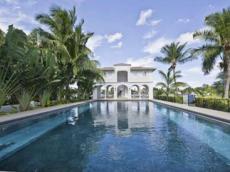|
|
TODAY.AZ / Weird / Interesting
Gangster's mansion on sales list in Miami
10 February 2014 [13:41] - TODAY.AZ
 One of Miami Beach's most notorious pieces of real estate is back on the block: the asking price is almost $8.5 million.
One of Miami Beach's most notorious pieces of real estate is back on the block: the asking price is almost $8.5 million.The sprawling, waterfront compound is where notorious Chicago gangster Al Capone died after being released from Alcatraz and is said to have plotted the St. Valentine's day massacre in 1929.
The 10,000-square-foot baby blue mansion sits on exclusive Palm Island, sandwiched in Biscayne Bay between downtown Miami's skyscrapers and South Beach's hotel district.
The current owner, a Florida company managed by New York accountant Anthony Panebianco, purchased the home barely six months ago for $7.4 million, according to Miami-Dade property records.
The mansion was built in 1922 by Clarence Busch, a member of the Anheuser-Busch brewing family. Capone, who made a vast fortune importing and selling liquor during prohibition, bought it in 1928 for $40,000 after being chased out of Chicago and later Los Angeles, according Ron Chepesiuk, a journalist and author of the book Gangsters of Miami.
"A lot of the booze he was marketing was coming through Miami and south Florida," said Paul George, a leading Florida historian.
High-profile organized crime figures were a mainstay of Miami's early days, in part because of its proximity to Havana, a popular gambling and watering hole for Americans during the prohibition era.
A generation after Capone, Meyer Lansky - known as the "Mob Accountant" - owned a condominium on Miami Beach and in the 1950s operated casinos in Cuba before the communist revolution.
Capone's arrival in Florida caused an uproar. Newspapers followed his every move. Then-Governor Doyle Carlton ordered sheriffs throughout the state to arrest him on sight.
Capone attempted to charm the locals, promising not to break the law and giving sizeable donations to politicians. He also turned the property into a fortress, with heavy wooden doors, concrete walls and a gatehouse.
Bodyguards were a constant presence both at the home and as Capone traveled through Miami, spending $1,000 at a time on clothing in newly burgeoning downtown Miami or gambling at Miami Beach casinos and dog tracks.
The bodyguards' numbers doubled, according to Chepesiuk, after the Valentine's Day Massacre, when Capone's Chicago associates lured members of a rival gang into an ambush disguised as a liquor deal. Seven men were lined up against a wall inside a garage and executed by men dressed in police uniforms and in suits.
"While the most spectacular gangland slaying in mob history was going down in Chicago, (Capone) was 1,300 miles away at a party at his Palm Island estate, providing him with a perfect alibi," Chepesiuk wrote.
After Capone died in 1947, the home remained in his family until sometime in the 1970s, when it was bought by Henry Morrison, a pilot for Delta Airlines, according to George.
"It was in a pretty ramshackle condition. He had girlfriends coming over, and it was a real bachelor pad," he said.
After falling into disrepair in the 1970s and 1980s, the house was restored and put back on the market for nearly $10 million in 2011.
Despite being the site of Capone's death after he returned from Alcatraz as a mental patient, driven to insanity by syphilis, the house climbs in price each time it changes hands, said Albert Justo, of One Sotheby's International Realty, who is representing the owner.
"People love the fact that it's part of Miami history," he said.
/Reuters/
URL: http://www.today.az/news/interesting/130769.html
 Print version
Print version
Views: 2304
Connect with us. Get latest news and updates.
See Also
- 19 February 2025 [22:20]
Visa and Mastercard can return to Russia, but with restrictions - 05 February 2025 [19:41]
Japan plans to negotiate with Trump to increase LNG imports from United States - 23 January 2025 [23:20]
Dubai once again named cleanest city in the world - 06 December 2024 [22:20]
Are scented candles harmful to health? - 23 November 2024 [14:11]
Magnitude 4.5 earthquake hits Azerbaijan's Lachin - 20 November 2024 [23:30]
Launch vehicle with prototype of Starship made its sixth test flight - 27 October 2024 [09:00]
Fuel prices expected to rise in Sweden - 24 October 2024 [19:14]
Turkiye strikes terror targets in Iraq and Syria - 23 October 2024 [23:46]
Kazakhstan supplied almost entire volume of oil planned for 2024 to Germany in 9 months - 23 October 2024 [22:17]
Taiwan reported passage of Chinese Navy aircraft carrier near island
Most Popular
 Azerbaijan, Israel hold fourth joint commission meeting in Jerusalem
Azerbaijan, Israel hold fourth joint commission meeting in Jerusalem
 Victim testimonies heard as trial of Ruben Vardanyan continues in Baku Military Court
Victim testimonies heard as trial of Ruben Vardanyan continues in Baku Military Court
 Baku hosts second day of International Banking Forum
Baku hosts second day of International Banking Forum
 Turkiye expands its African sphere of influence with bold Libya shift
Turkiye expands its African sphere of influence with bold Libya shift
 AzInTelecom participates as key partner at 9th International Banking Forum
AzInTelecom participates as key partner at 9th International Banking Forum
 IFC marks 30 years of support for Azerbaijan’s economic development
IFC marks 30 years of support for Azerbaijan’s economic development
 Shein, Temu, AliExpress toys pose risks to children
Shein, Temu, AliExpress toys pose risks to children
